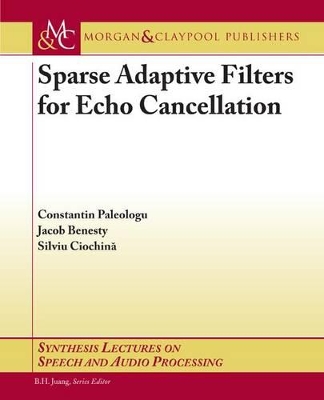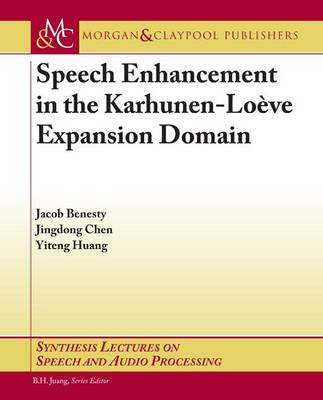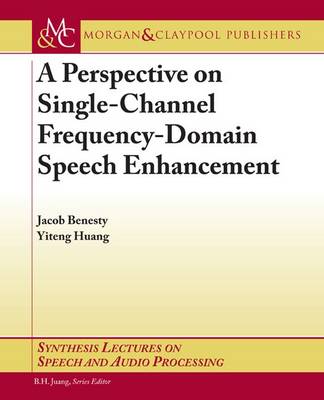Synthesis Lectures on Speech & Audio Processing
3 total works
Sparse Adaptive Filters for Echo Cancellation
by Constantin Paleologu, Jacob Benesty, and Silviu Ciochina
Published 2 June 2010
Adaptive filters with a large number of coefficients are usually involved in both network and acoustic echo cancellation. Consequently, it is important to improve the convergence rate and tracking of the conventional algorithms used for these applications. This can be achieved by exploiting the sparseness character of the echo paths. Identification of sparse impulse responses was addressed mainly in the last decade with the development of the so-called ``proportionate''-type algorithms. The goal of this book is to present the most important sparse adaptive filters developed for echo cancellation. Besides a comprehensive review of the basic proportionate-type algorithms, we also present some of the latest developments in the field and propose some new solutions for further performance improvement, e.g., variable step-size versions and novel proportionate-type affine projection algorithms. An experimental study is also provided in order to compare many sparse adaptive filters in different echo cancellation scenarios.
Speech Enhancement in the Karhunen-Loeve Expansion Domain
by Jacob Benesty, Jingdong Chen, and Yiteng Huang
Published 4 January 2011
This book is devoted to the study of the problem of speech enhancement whose objective is the recovery of a signal of interest (i.e., speech) from noisy observations. Typically, the recovery process is accomplished by passing the noisy observations through a linear filter (or a linear transformation). Since both the desired speech and undesired noise are filtered at the same time, the most critical issue of speech enhancement resides in how to design a proper optimal filter that can fully take advantage of the difference between the speech and noise statistics to mitigate the noise effect as much as possible while maintaining the speech perception identical to its original form. The optimal filters can be designed either in the time domain or in a transform space. As the title indicates, this book will focus on developing and analyzing optimal filters in the Karhunen-Loève expansion (KLE) domain. We begin by describing the basic problem of speech enhancement and the fundamental principles to solve it in the time domain. We then explain how the problem can be equivalently formulated in the KLE domain. Next, we divide the general problem in the KLE domain into four groups, depending on whether interframe and interband information is accounted for, leading to four linear models for speech enhancement in the KLE domain. For each model, we introduce signal processing measures to quantify the performance of speech enhancement, discuss the formation of different cost functions, and address the optimization of these cost functions for the derivation of different optimal filters. Both theoretical analysis and experiments will be provided to study the performance of these filters and the links between the KLE-domain and time-domain optimal filters will be examined.
A Perspective on Single-Channel Frequency-Domain Speech Enhancement
by Jacob Benesty and Yiteng Huang
Published 1 March 2011
This book focuses on a class of single-channel noise reduction methods that are performed in the frequency domain via the short-time Fourier transform (STFT). The simplicity and relative effectiveness of this class of approaches make them the dominant choice in practical systems. Even though many popular algorithms have been proposed through more than four decades of continuous research, there are a number of critical areas where our understanding and capabilities still remain quite rudimentary, especially with respect to the relationship between noise reduction and speech distortion. All existing frequency-domain algorithms, no matter how they are developed, have one feature in common: the solution is eventually expressed as a gain function applied to the STFT of the noisy signal only in the current frame. As a result, the narrowband signal-to-noise ratio (SNR) cannot be improved, and any gains achieved in noise reduction on the fullband basis come with a price to pay, which is speech distortion. In this book, we present a new perspective on the problem by exploiting the difference between speech and typical noise in circularity and interframe self-correlation, which were ignored in the past. By gathering the STFT of the microphone signal of the current frame, its complex conjugate, and the STFTs in the previous frames, we construct several new, multiple-observation signal models similar to a microphone array system: there are multiple noisy speech observations, and their speech components are correlated but not completely coherent while their noise components are presumably uncorrelated. Therefore, the multichannel Wiener filter and the minimum variance distortionless response (MVDR) filter that were usually associated with microphone arrays will be developed for single-channel noise reduction in this book. This might instigate a paradigm shift geared toward speech distortionless noise reduction techniques.


